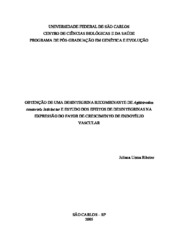Obtenção de uma desintegrina recombinante de Agkistrodon contortrix laticinctus e estudo dos efeitos de desintegrinas na expressão do fator de crescimento de endotélio vascular.
Abstract
Disintegrins are snake venom proteins used in the study of integrin-mediated cellular
adhesion through integrins. Recombinant disintegrin production may notable supply faster,
larger and most homogeneous protein samples than bruit venom processing. This work
describes optimization of the recombinant ACLD-C expression technique. ACLD-C is a
disintegrin-like protein from Agkistrodon contortrix laticinctus, that have a disintegrin-like
domain with DCD motif, and a cysteine-rich domain. This protein was subcloned from the
ACLD clone (GenBank U86634), a metallopeptidase. A protocol of expression was
established in our laboratory, where recombinant ACLD-C is produced in E. coli, using the
expression vector pMal-p. This allows protein target expression in form of N-terminal fusion
with MBP (maltose-binding protein), that facilitate purification, correct folding and
production of disintegrin in soluble form. In fact, MBP/ACLD-C was was expressed in
soluble form and purified in two stages: affinity comatography in amilose resin and
cromatography of gel-filtration in superdex-200 resin. Modifications in expression protocol
optimized MBP/ACLD-C expression in culture of 0,4 mg/L of culture of 1,2 mg/L (12,6%
total of protein in periplasmic space of E.coli). MBP/ACLD-C imobilizated in amilose resin
was subjected to digestion with enzyme factor Xa to separate ACLD-C of MBP. The
separation was confirmed through positive reaction with anti-ALT-C antibody. ALT-C is a
disintegrin-like protein from Bothrops alternatus. ALT-C induced both expression of VEGF
in human fibroblasts and proliferation of endothelial cells and angiogenesis. In second part of
this work, we investigated if MBP/ACLD-C was also able to induce the expression of this
growth factor in this cells. MBP/ACLD-C and two other disintegrins, echistatina, a
disintegrin-RGD, and EC6, a heterodimeric disintegrin, were incubated with fibroblasts. The
influency of these proteins in VEGF expression was evaluated by ELISA. MBP/ACLD-C was
able to strongly induce the expression of VEGF until 4 hours, when the level decreased until
24 hours. Experiment in period of 24 48 hours was not done due to problems of
contaminations. Echistatin did not induced VEGF expression, but induced fibroblasts
dettachment from plastic. The latter event was not observed in MBP/ACLD-C or EC6
incubated cells.
